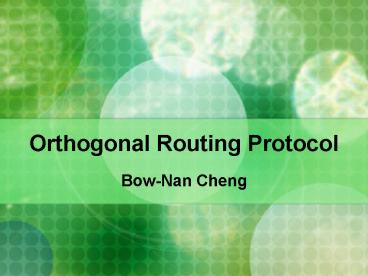Orthogonal Routing Protocol PowerPoint PPT Presentation
1 / 17
Title: Orthogonal Routing Protocol
1
Orthogonal Routing Protocol
- Bow-Nan Cheng
2
ORP Overview
- Introduction / Basic Principles
- Design Goals
- Key Assumptions
- Key Advantages/Benefits of ORP
- ORP Technical Specifications
- Key Obstacles to Overcome
- Simulation Parameters
- Simulation Results (Todo)
3
Introduction
- Orthogonal Routing Protocol (ORP) is a
lightweight, stateless, and distributed routing
protocol based on rendezvous point abstractions.
It is designed to provide connectivity under
extreme conditions of high-speed mobility, sparse
node environments, connectivity disruptions and
minimal information due to lack of global
positioning systems (ie GPS), neighbor states,
among others.
4
ORP Basic Concepts
- FSO transmissions are directional by nature with
minimal beam-width - Drawing two pairs of perpendicular lines
intersecting at two different nodes will always
yield atleast 1 intersection in each direction
between the perpendicular line pairs (see
picture)
5
ORP Basic Concepts
- In many cases, nodes will have different sense of
direction (ie Node D thinks north is to the
right while Node A thinks north is up) - Orthogonal intersections will yield a rendezvous
point/node regardless of individual nodes sense
of direction - Supposing Node A wishes to send to Node D, the
path taken would be through the
intersection/rendezvous node as show in picture
6
ORP Design Goals
- Provide Connectivity Under Extreme Conditions and
with Minimal Information - Extreme Conditions
- High Speed Mobility
- Sparse Networks
- RF Connectivity Disruptions (ie Jamming etc.)
- Minimal Information
- Lack of global positioning system (ie GPS)
- Lack of localization systems (GLS, Landmark etc.)
- No link state information
- No ability for basic neighbor discovery
7
Key Assumptions / Definitions
- Directional FSO Transceivers
- tessellated to simulate
- omni-directional ability
- if all transmitting/receiving
- at the same time
- Node Local Sense of Direction
- 2-D Flat Plane Topology (future work to include
3-D) - Def ORP Broadcast A node sending information
through 4 orthogonal transceivers only
8
ORP Key Advantages
- Connectivity Under Extreme Conditions
- Efficient Medium Usage (FSO Property)
- Increased Security (FSO Property)
- True Stateless Nature
- Minimal Information Needed for Successful Routing
9
Technical Specs - Overview
- ORP Broadcast is performed at set intervals Ok
because medium usage is minimal in ORP Broadcast
(vs. flooding) - Probe and broadcast packets have a TTL associated
with them to stop continuous send - First rendezvous node found will be used to
forward packets (even though atleast 2 will be
found this will help choose better paths)
10
Technical Specs Packet Info
- ORP Broadcast Packet - Periodic packets sent to
update location in highly mobile environments - ORP Probe Packet - Find a Source to Destination
Rendezvous Node to send packets - ORP Probe Packet ACK - Rendezvous Nodes that send
ACKs will give the sender a more specific
direction to forward packets. If no ACK is
received, sender can still ORP Broadcast all
their data but this is not suggested - Data Packet Data to be sent
11
Tech Specs Forwarding Tables
- Note only 1-hop tables maintained. Because of
nature of ORP broadcast, forwarding tables might
not include all immediate 1 hop neighbors
12
Technical Specs - Algorithm
- ORP Broadcast
- Using local sense of direction, each node sends
an ORP broadcast packet in orthogonal directions - ORP Forwarding Table Build
- Upon receipt of ORP Broadcast PKT, build
forwarding table (NB ID neighbor ID, Dir
Direction, Dest ID Source of ORP Broadcast) - If TTL on ORP Broadcast Packet not expired, send
packet along path in same direction (send
transceiver is 180 degrees from receive
transceiver)
13
Technical Specs - Algorithm
- ORP Probing
- When a node receives an ORP Probe Packet, check
to see if we have the destination ID in our
forwarding table - If destination ID not in our forwarding table
- Add 180 degrees to the orientation of the
transceiver that received it and send out of
nearest transceiver - Else
- Send ORP Probe ACK packet back through
transceiver we received from
14
Technical Specs- Algorithm
- Data Packet Forwarding
- - When a node receives an Data Packet, check to
see if we have the destination ID in our
forwarding table - - If destination ID not in our forwarding table
- - Add 180 degrees to the orientation of the
transceiver that received it and send out of
nearest transceiver - Else
- Send it in the direction of destination
15
Key Obstacles to Overcome
- Alignment Issue
- Problem FSO links need alignment and line of
sight - Workarounds
- THz FSO can go through walls
- Previous work for tessellated transceivers allows
for alignment by setting up a virtual
omnidirectional environment - Increase FSO beamwidth
- Sparse Network Issue
- Problem In sparse networks, what if ORP
broadcast yields no returns? - Workarounds
- Send broadcast packets on all FSO transceivers to
simulate a traditional broadcast (other
algorithms can be tested for more efficiency) in
case of no response in all 4 directions. - High Mobility Issue
- Problem High mobility makes rendezvous points
obsolete quickly - Workarounds
- ORP broadcast at set intervals
- Broadcasts can include movement trajectory
information
16
Simulation Parameters / Metrics
- Claim Connectivity Under Extreme Conditions
- Metric Data packet successful delivery
percentage - Conditions
- High Mobility
- Sparse Networks
17
Simulation Results (todo)

